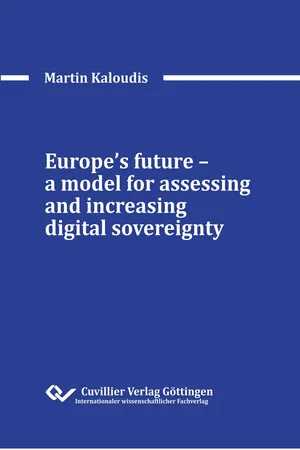
- 272 pages
- English
- PDF
- Available on iOS & Android
About this book
Die Dissertation "Europe's future – a model for assessing and increasing digital sovereignty" von Martin Kaloudis an der Mendel University in Brno beschäftigt sich mit der digitalen Souveränität europäischer Staaten. Sie thematisiert die Abhängigkeit der EU-Staaten von Technologien und Rohstoffen aus Nicht-EU-Ländern, insbesondere die Abhängigkeit von digitalen Technologien aus China und den USA, und untersucht mögliche Stellhebel zur Beherrschbarkeit von Abhängigkeiten von nicht-europäischen Technologien. Die Dissertation entwickelt ein Modell zur Bewertung der digitalen Souveränität, fokussiert auf die EU, und schlägt eine Definition des Begriffs vor. Ein wichtiger Bestandteil ist ein komparativer Index für digitale Souveränität, der auf sekundären Daten basiert und mittels quantitativer Methoden verifiziert und validiert wird. Die Ergebnisse des Indexes zeigen, dass EU-Staaten in Sachen digitaler Souveränität Entwicklungspotenziale haben. Aus der Analyse werden handlungsleitende Maßnahmen abgeleitet, wie etwa höhere Investitionen in Start-ups, Förderung des Exports von IKT-Dienstleistungen und Verringerung von Handelsbarrieren im digitalen Bereich. Die Dissertation betont, dass die konsequente Umsetzung dieser Maßnahmen zur Stärkung der digitalen Souveränität der EU-Staaten beitragen kann.
Frequently asked questions
- Essential is ideal for learners and professionals who enjoy exploring a wide range of subjects. Access the Essential Library with 800,000+ trusted titles and best-sellers across business, personal growth, and the humanities. Includes unlimited reading time and Standard Read Aloud voice.
- Complete: Perfect for advanced learners and researchers needing full, unrestricted access. Unlock 1.4M+ books across hundreds of subjects, including academic and specialized titles. The Complete Plan also includes advanced features like Premium Read Aloud and Research Assistant.
Please note we cannot support devices running on iOS 13 and Android 7 or earlier. Learn more about using the app.
Information
Table of contents
- 1. Introduction
- 2. Literature research
- 2.1. Sovereign digitalisation, or digital sovereignty of the state
- 2.2. Technologisation and the role of the state
- 2.3. Digital Sovereignty ≠ Digitalisation + Sovereignty
- 2.4. Assignment to economic theories
- 2.5. Research gap
- 3. Objectives
- 4. Methodology
- 4.1. Research design
- 4.2. Structured interviews; qualitative research
- 4.3. Index development
- 4.4. Quantitative analysis: model bases
- 4.5. Selection of secondary data
- 4.6. Replacement methods for missing data
- 4.7. Normalisation methods
- 4.8. Appropriate weighting methods
- 4.9. Index aggregation methods
- 4.10. Methods of index and parameter analysis
- 4.11. Methods of uncertainty/sensitivity analysis
- 4.12. Verification and validation
- 5. Empirical analysis and results
- 5.1. Qualitative definition of digital sovereignty in the Europeancontext
- 5.2. Results of interviews
- 5.3. From quality to quantity: theoretical framework
- 5.4. Secondary data as a calculation basis for the sub-components
- 5.5. Summary of the data
- 5.6. Analysis of the data
- 5.7. Replacement of missing data
- 5.8. Normalisation
- 5.9. Weightings
- 5.10. Aggregation
- 5.11. Index formation DSI
- 5.12. Index validation, uncertainty and sensitivity analysis
- 5.13. Calculation of the DSI
- 5.14. Verification through simulation
- 5.15. Verification and validation through existing country indices
- 5.16. Analysis of individual states and clustering
- 5.17. Overarching view
- 6. Recommendations
- 6.1. Fields of Actions at individual state-level/individual analysis
- 6.2. Fields of Actions at individual state-level/group analysis
- 6.3. Optimum: joint initiative at EU-level
- 7. Discussion
- 7.1. Concept of digital sovereignty
- 7.2. Measurability of digital sovereignty
- 7.3. Comparison with other existing indices
- 7.4. Derivation of (political) recommendations
- 7.5. Limitations of the theoretical model
- 8. Conclusions
- References
- Appendix
- Questionnaire, long form
- Questions and answer patterns of the interviewees
- Answers in the structured interviews
- DSI score and ranks
- Scatter plot Xi
- Measures of determination Xi Mean and kNN imputation